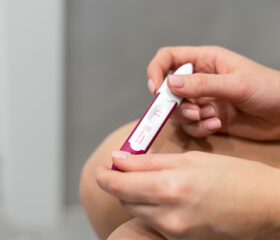Can You Safely Dye Your Hair While Pregnant?
For all the moms-to-be who love to dye their hair, great news—you can still have fun with your hair while you’re pregnant.

With all the dietary restrictions and lifestyle adjustments you have to make during pregnancy, you might be wondering whether you should put a pause on dyeing your hair. Fortunately (and perhaps surprisingly), the answer is no—you can still dye your hair when you’re pregnant, at least most of the time.
Read to learn when you might want to keep hair dye out of your life, with a few tips on how to dye your hair safely during pregnancy.
Is dyeing your hair safe while pregnant?
Again, yes, it’s generally safe to dye your hair while pregnant. While your scalp may absorb a small amount of hair dye, most experts agree it won’t harm your baby. Animal studies suggest that high doses of chemicals in hair dye could cause birth defects, but it’s unlikely that enough will absorb from normal use of hair dye to harm either you or your baby. 1
The government regulates hair dye to ensure it’s free of safety issues. For instance, all color additives, except for coal-tar hair dye, must be approved by the US Food and Drug Administration (FDA) before they can be used.
They also amended their color additives regulations in 2022 to prohibit using lead acetate (which can lead to cancer and birth defects) in hair dye. 2 3
Why some doctors recommend not dyeing your hair while pregnant
With all that said, some doctors still suggest you avoid using hair dye during pregnancy, or at least in the first trimester. Those first 12 weeks are the most vulnerable time for your baby, as the foundations of his organs and body systems are forming. 4
These doctors don’t claim that there’s proof that hair dye is toxic to your fetus—just that it’s best to err on the side of caution. 5 It’s hard or impossible to come up with a truly definitive verdict on this subject because it’s hard to research ethically (researchers can’t subject pregnant women to high doses of hair dye the way they can with animals).
Because not all doctors agree, it’s up to you to decide how comfortable you are with the risk.
Is bleaching your hair safe while pregnant?
By and large, it’s also safe to bleach your hair while pregnant. Experts don’t have any evidence suggesting that bleaching your hair will lead to birth defects.
Again, if you want to play it absolutely safe, consider only bleaching your hair after your first trimester, and try to avoid applying any bleach directly to your scalp.
Which type of hair dye should you use while pregnant?
There are three types of hair coloring, listed below:
- Permanent hair dye: This dye typically contains ammonia and hydrogen peroxide (a type of bleach). It changes the structure of the hair cuticle and sinks in.
- Semi-permanent hair dye: By contrast, semi-permanent dyes don’t have chemicals like ammonia or peroxide. They coat your hair shaft but don’t actually change the underlying tissue, and gradually fade away with each wash.
- Temporary hair dye: This also coats the hair shaft but is less vibrant and doesn’t last as long as semi-permanent dye.
You may be better off using semi-permanent and temporary dyes when you’re pregnant because they have a lower chemical content.
If you’re still considered, consider opting for highlights, lowlights, frosting, or streaking hair treatments instead of all-over color. These just touch your hair shaft, not your skin. 6
How to dye your hair safely when you’re pregnant
As you’re probably gathering, if you want to be as safe as possible, look for low-chemical options. This means picking ammonia-free, peroxide-free, and paraben-free semi-permanent or temporary colors.
If you’re looking for a natural alternative, you can also opt for vegetable-based dyes like pure henna.
When you actually color your hair, follow these tips:
- Do it in a well-ventilated area: It’s important to make sure the room has plenty of space and fresh air so that you’re not breathing in excessive fumes (i.e., chemicals) from the hair dye. 5
- Do a patch test: Check if you’re allergic to the dye before you use it. To do so, apply a little on the inside of your elbow or behind your ear and leave it on for two days to see if you get a rash or any other adverse reaction. 7
- Wear gloves: If you’re dyeing your hair yourself (more on that below), use gloves to protect your skin when you apply the dye.
- Follow the instructions: Don’t go rogue and leave the dye on longer than the package recommends or do anything else that’s contrary to the instructions.
- Use one product at a time: Mixing different hair dye products can hurt your hair and scalp. 7 That’s true both when you’re pregnant and when you’re not.
- Rinse thoroughly: Clean your scalp thoroughly with water after dyeing your hair.
- Choose US-made hair dyes: Hair dyes made in other countries aren’t always as well-regulated as those made in the US. They might contain toxic substances that are banned in the US. 6
Dyeing at home vs. visiting a professional
You can dye your hair at home as long as you know how to apply the dye and safely handle the chemicals. Doing it yourself will give you full control over the dye you use.
However, if you’ve never dyed your hair before, it might be safer to get it done by a professional. They can make sure that little to no dye touches your scalp.
One downside of going to a hair salon is that you could breathe in fumes from other products. If you choose to go to a salon, let your stylist know you’re pregnant so that they can take appropriate precautions.
How to maintain your hair color while you’re pregnant
The texture of your hair may change over the course of your pregnancy. 8 This means that when you dye it, the results might be different than usual, so doing a strand test is a good idea.
Your hair color will last longer if you wash it less often (e.g., 2–3 times a week) and use dry shampoo in between. Use sulfate-free shampoo and conditioner and avoid heat styling tools like curling irons and flat irons, as they can make the color fade faster.
Can you work as a hairstylist while pregnant?
Yes, you can work as a hairstylist while you’re pregnant. Just make sure you’re working in proper conditions and minimizing your exposure to chemicals as much as possible. (Again, there’s no real evidence that most hair dyes are harmful, but it’s always better to be safe than sorry.)
Make sure your workplace is well-ventilated and that you wear protective gloves and take regular breaks. You should also eat and drink outside of your workplace, after washing your hands thoroughly. 6
It might be worth asking your boss if you can switch to cutting and styling work and do less chemical work during your pregnancy.
Is it safe to dye your hair while breastfeeding?
As you know, it’s generally no problem to dye your hair when you’re pregnant, but what about after your baby is born and you’re breastfeeding him?
The answer here is the same: most doctors say it’s safe to dye your hair while breastfeeding. There aren’t any studies that suggest doing so will harm your baby. 6 Of course, if you’re still in doubt, you can discuss this in more detail with your doctor (or just postpone dyeing your hair until you switch your baby to solids if you want to be extra safe).
Final thoughts
You have to make a lot of sacrifices during your pregnancy, but luckily, dyeing your hair isn’t one of them.
Still, it isn’t a bad idea to wait until your second trimester to touch up your hair. After that, as long as you’re taking reasonable safety precautions, go nuts!
Article Sources
- Canadian Family Physician. "Safety of hair products during pregnancy" Retrieved April 24, 2025.
- Emory University. "Lead acetate" Retrieved April 24, 2025.
- U.S. Food & Drug Administration. "Hair Dyes" Retrieved April 24, 2025.
- Johns Hopkins Medicine. "The First Trimester" Retrieved April 24, 2025.
- American Cancer Society. "Hair Dyes and Cancer Risk" Retrieved April 24, 2025.
- MotherToBaby. "Hair Treatments" Retrieved April 24, 2025.
- U.S. Food & Drug Administration. "Cosmetics Safety Q&A: Hair Dyes" Retrieved April 24, 2025.
- MedlinePlus. "Skin and hair changes during pregnancy" Retrieved April 24, 2025.







